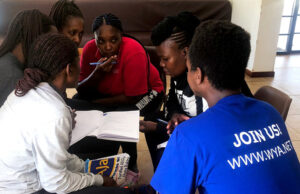The following is an excerpt of an article by Vincenzina Santoro, international economist, UN representative for the American Family Association of New York, and member of the WYA Board. In the article, she explores the connections between various governmental, intergovernmental and non-governmental actors in promoting contraceptives in international development. The article was originally published in the Summer 2018 issue of Human Life Review.
The global contraceptives market was estimated to be $22 billion in 2016 and projected to rise to $37 billion by 2025.[1] To promote contraceptive use, especially among youth, manufacturers and other family planning advocates commemorate World Contraceptive Day on September 26. Arguably, however, contraceptive profits would not have risen nearly so high without the decades-long efforts of the United Nations to drastically rein in population growth by a variety of interventions to prevent conception or to intervene when it has already taken place.
In 1969, the United Nations created the United Nations Fund for Population Activities (later renamed the United Nations Population Fund) to address a broad range of population matters, from assistance with population censuses to various aspects of maternal care. However, with the Sixties’ newly developed contraceptive pills and other birth suppression devices creating a synergistic population control wave, UNFPA soon became a major protagonist in family planning. For years now it has employed the slogan: “Every child a wanted child,” without explicitly spelling out what one should do in the event of an unanticipated pregnancy.
The “birth of birth control” dates back to the early 1960s, when the “pill” was medically approved as a contraceptive. Now “liberated” women could have sex at will without fear of pregnancy. Due to contraceptive failure, the need for the safety net of legalized abortion soon became apparent. Not surprisingly, therefore, abortion was legalized not only in the United States but in other major countries by the 1970s.
In combination with other factors (including abortion), the contraceptive pill and other forms of pregnancy prevention contributed to a gradual decrease in fertility rates throughout most of the developed world. In the United States, fertility dropped during the 1960s and early 1970s to a level just at or above the population replacement level of 2.1 children per woman.[2] It then remained roughly constant until 2007, when fertility resumed its steady decline. In 2017, the American fertility rate was 1.76 (while the average fertility rate for the 28-member European Union was 1.57 and Japan’s fertility rate reached 1.41).
Today the only parts of the world showing high fertility rates are sub-Saharan Africa plus Afghanistan. Of the 224 countries, territories, and areas of the world for which there are estimated data, 105 are at or above the 2.1 level. The highest fertility rates are recorded by Niger (6.49), Angola (6.16), and Mali (6.01); at the bottom are Taiwan (1.13), Macau (0.95), and Singapore (0.83).[3] Diagnosing high fertility rates as a chief impediment to health and prosperity, UNFPA moved to ensure sufficient stocks of “high quality” contraceptive products and actively encourage their use among an estimated 225 million women.[4] Thus, UNFPA became a partner in the “Reproductive Health Supplies Coalition.” But first a word about “reproductive.”
Introducing the Sustainable Development Goals
The word “reproductive” enjoys significant status in the documents produced at the United Nations. UNFPA, WHO (World Health Organization), and assorted activists promote “sexual and reproductive health and services and reproductive rights” at every turn. They are especially persistent about including this language in the “outcome documents” produced at annual meetings of the Commission on the Status of Women, the Commission for Social Development, the Commission on Population and Development, and the High Level Political Forum on Sustainable Development. Activists then use these and other documents to persuade countries to fill “the unmet need for family planning” and ensure “safe and legal abortion”—ostensibly to reduce poverty, save women’s lives, and promote their empowerment.
Their biggest victory came in 2015 with the adoption by the United Nations General Assembly of the Sustainable Development Goals,[ which consisted of 17 goals, 169 targets, and 231 indicators with the ultimate aim of eradicating poverty by 2030. In Goal 3, relating to global health, activists succeeded in including the following language in Target 3.7: “By 2030, ensure universal access to sexual and reproductive health-care services, including for family planning, information and education, and the integration of reproductive health into national strategies and programmes.” In addition, under Goal 5, dealing with gender equality and the empowerment of women, Target 5.6 states: “Ensure universal access to sexual and reproductive health and reproductive rights as agreed in accordance with the Programme of Action of the International Conference on Population and Development and the Beijing Platform for Action and the outcome documents of their review conferences.”
The Reproductive Health Supplies Coalition
UNFPA’s influence on population control extends beyond its individual activities. It is also a partner in the Reproductive Health Supplies Coalition[6] founded in 2004. As of June 2018, this Brussels-based coalition consisted of 458 member organizations from dozens of countries (up from 203 in 2012), including 115 from the United States. Its primary purpose is expressed as follows:
The Coalition is a global partnership of public, private, and non-governmental organizations dedicated to ensuring that everyone in low- and middle-income countries can access and use affordable, high-quality supplies for their better reproductive health. It brings together agencies and groups with critical roles in providing contraceptives and other reproductive health supplies. These include multilateral and bilateral organizations, private foundations, governments, civil society, and private sector representatives.[7]
Non-governmental members include advocacy organizations, funders, manufacturers of pharmaceutical products and medical devices, various non-profits, and assorted academic institutes.
In addition to UNFPA, some of the more prominent members include the International Planned Parenthood Federation (which is headquartered in London), International Planned Parenthood/Western Hemisphere Region (headquartered in New York City), the Bill and Melinda Gates Foundation, Catholics for Choice, CARE USA, David and Lucile Packard Foundation, Engender Health, Evofem Biosciences, Family Care International, Female Health Institute, Friends of UNFPA, Guttmacher Institute, International Partnerships for Microbicides, International Consortium for Emergency Contraception, International Youth Alliance for Family Planning, Ipas, Jhpiego (an affiliate of Johns Hopkins University), MacArthur Foundation, John Templeton Foundation, Medicines360, Merck Sharp & Dohme, Male Contraception Initiative, PATH, Pathfinder International, Population Reference Bureau, Population Services International, USAID, United Nations Foundation (founded by Ted Turner), William and Flora Hewlett Foundation, Women Deliver, World Health Partners, the World Bank, and the World Health Organization.
Every few years the Coalition makes estimates for the perceived need and cost of family planning supplies—which are oddly referred to as “commodities”—for 135 low- and middle-income countries (as determined by the World Bank) in what they term the Commodity Gap Analysis. In their 2018 report they estimated that contraceptive spending in the prior year totaled $2.55 billion, of which $2.1 billion was funded by the private sector and $463 million by governments. To satisfy perceived future demand, the Coalition estimated that by 2020 there will be 493 million users of various contraceptive forms, requiring $8.45 billion over the three-year period.[8]
Click here to read the rest of this article on the Human Life Review website.
To learn more about this topic, check out WYA’s white paper on reproductive health.
[1] https://www.transparencymarketresearch.com/pressrelease/contraceptives-market.htm
[2] https://fred.stlouisfed.org/series/SPDYNTFRTINUSA
[3] Data refer to 2017. https://www.cia.gov/library/publications/the-world-factbook/rankorder/2127rank.html#ja
[4] The Lancet/Women Deliver, “Deliver for Good,” 10.
[6] https://www.rhsupplies.org/
[7] https://www.rhsupplies.org/uploads/tx_rhscpublications/Commodity_Gap_Analysis-2018.pdf
[8] Ibid.







